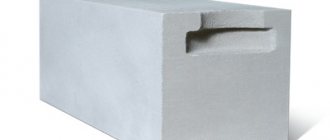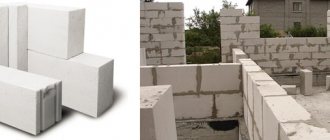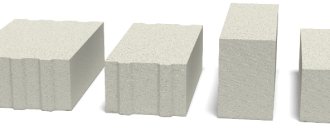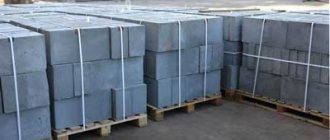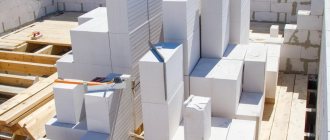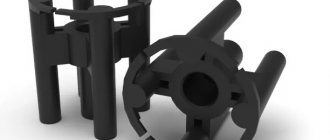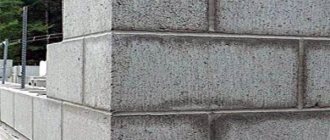Beton-House.com
Website about concrete: construction, characteristics, design. We combine the experience of professionals and private craftsmen in one place
House made of aerated concrete "Ytong"
Brand "Ytong" - aerated concrete blocks that are produced. It was formed in 2003 by the merger of three German companies, Haniel-BauIndustrie GmbH and Fels-Werke GmbH.
Currently, Xella is one of the largest manufacturers of not only aerated concrete products, but also many other construction products, both in Germany and on the world market.
- Strength of Itong aerated concrete
- Ytong U-shaped blocks
Products
In the construction market, the Xella company represents several areas of work:
- Production of building materials;
- Production of insulating panel systems;
- Extraction and processing of limestone and lime - FELS brand.
The production of building materials is carried out in several groups:
- Aerated concrete products – brand “Ytong”;
- Sand-lime brick – brand “Silka”;
- Large format reinforced aerated concrete panels - Hebel brand.
Insulation panel systems also include the production of Fermacell gypsum fiber sheets.
Products
The entire range of products is of high quality. When developing new technologies, innovative solutions are used.
Product quality
Quality control of manufactured products is ensured by:
- Strict adherence to all technological processes during the production of products;
- Having our own modern building materials research center;
- Checking the quality of raw materials and the final product in our own laboratories.
The world's largest research complex is located in Germany.
Quality control of incoming raw materials and technical parameters of manufactured products
The company is constantly improving the technical qualities of its products and improving their manufacturing technologies.
— activities in Russia
In the Russian construction market, the Xella enterprise began to develop its activity with the construction of a plant for the production of aerated concrete products of the Ytong brand. It was based in the city of Mozhaisk (launched in 2007).
Territory for the production of autoclaved aerated concrete in Mozhaisk
In addition to the production area in Russia, the Xella company also constantly conducts training on working with Ytong materials and demonstrates new methods for processing aerated concrete products.
2 Features of Aerok aerated concrete production
Aeroc aerated concrete is an environmentally friendly building material made from components of natural origin:
- finely ground quartz sand;
- high grade cement without additives;
- ground unslaked lime;
- gypsum and water.
- aluminum powder in small quantities.
After gas formation is carried out, as well as giving the aerated concrete blocks strength through the autoclave processing process, the aerated concrete mass is resolved into separate blocks with a clearly defined geometry.
To achieve final strength, they are dried in the open air. The strength of a building material during production and processing changes by combining the number of initial components and controlling the swelling of aerated concrete to a specific volume established by state standards.
Aerok aerated concrete production diagram
Additionally, gas blocks of the AEROC brand are manufactured without oil shale ash, which is another indicator of its highly environmentally friendly characteristics. An additional feature of the building material is that it consists of 70-80% air contained in the pores of aerated concrete.
After autoclave treatment, only up to 20 kg of chemically bound aluminum remains in aerated concrete, which enters the material in pure form and in the form of aluminum oxide, which is even used to create kitchen utensils.
The porous structure of the material allows the constructed walls to “breathe”, ensuring the creation of a natural microclimate in the room, as well as its environmental cleanliness and preventing the formation of fungal organisms, which is ideal for residential buildings.
Range of aerated concrete products
are produced:
- Blocks of various shapes and sizes for constructing wall structures;
- U-shaped elements;
- Arc-shaped blocks;
- Aerated concrete lintels with factory reinforcement;
- Prefabricated monolithic type floors;
- Plates for thermal insulation “Multipor”;
- Partition blocks of small thickness;
- Adhesive for aerated concrete;
- Elements for staircases;
- Tools for aerated concrete.
Each of the products of this brand is distinguished by excellent technical parameters and geometric dimensional accuracy.
Assortment of products made from aerated concrete "Itong"
This variety of products determines the wide range of applications of Ytong products.
Ytong housing construction system
The production of non-standard products from aerated concrete materials provides an excellent opportunity to implement a variety of individual projects.
Price-quality ratio"
We have discussed the features that Aerok aerated concrete has. Price is considered an equally important criterion when choosing a material. The cost of blocks in each region of the country does not differ too much from each other. The estimated price starts from 3,000 rubles per cubic meter. It is worth considering that the price is influenced by the following factors:
- construction season;
- location of company representative offices;
- type of purchased blocks;
- quantity.
Now that you have decided what you will build your house or cottage from, let’s talk about how to properly lay aerated concrete.
View gallery
Technical parameters of aerated concrete materials "Itong"
The main parameters by which you can evaluate the advantages of Itong aerated concrete are:
- Durability of products;
- Physical and mechanical indicators;
- Thermal insulation properties;
- Humidity of products;
- Vapor permeability of blocks;
- Sound insulation of wall structures;
- Frost resistance class;
- Fire resistance of the material;
- Accuracy of product geometry;
- Ease of material processing;
- Service life of buildings and structures;
- Seismic resistance;
- Ecological class.
Buildings made from Itong aerated concrete are energy efficient.
Variety of Ytong brand products
Aerated concrete simultaneously has two main advantages of a building material: high strength and excellent thermal insulation.
Strength of Itong aerated concrete
Despite their fairly low weight, Ytong aerated concrete blocks have great strength. Their use is possible both in load-bearing structures (up to 5 floors) and in non-load-bearing walls (up to 9 floors).
Physical and mechanical properties of the material
The main physical and mechanical parameters of Itong aerated concrete are provided by its porous structure, as well as the parameters of the components included in the composition.
Composition of aerated concrete "Ytong":
- Cement;
- Lime;
- Sand;
- Water;
- Aluminum gas generator.
The result of a chemical reaction and autoclave treatment is a material, most of the volume of which is occupied by tiny, evenly spaced pores containing air.
Components of Itong aerated concrete
Thanks to this structure of the material, products made from it have high thermal insulation and sound insulation properties.
Basic physical and technical characteristics of Itong aerated concrete
The parameters of Ytong aerated concrete products are much higher than the requirements of GOST 31360-2007, which standardize the production of cellular concrete blocks.
Thermal insulation of aerated concrete products "Itong"
The largest amount of heat is lost by the building through external structures. Itong aerated concrete systems, intended for the construction of external walls, as well as floors and roofs, have a very high degree of thermal insulation. They conduct heat equally poorly in all directions of their structure.
Thermal characteristics of Itong aerated concrete are the same throughout the entire structure of the product
Creating thin-seam masonry using adhesives and using a tongue-and-groove system allows you to maintain high thermal insulation performance of aerated concrete.
In addition, products made from Itong aerated concrete have the ability to accumulate heat during the day, gradually releasing it when the ambient temperature drops. By preventing active heat exchange between the internal and external environments, aerated concrete blocks help create a favorable atmosphere indoors.
Comparative table of coefficients for thermal conductivity of various aerated concrete in a dry state - W/mC:
| Concrete grade | |||
| D 400 | D 500 | D 600 | |
| "Itong" | 0,088 | 0,099 | 0,112 |
| Aerostone aerated concrete blocks | 0,096 | 0,120 | 0,140 |
| Aerated concrete blocks "Bicton" | 0,096 | 0,120 | 0,140 |
| Aerated concrete "UDK" | 0,100 | 0,120 | 0,140 |
As can be seen from this table, Ytong aerated concrete blocks have high thermal insulation parameters in comparison with other brands.
Humidity of aerated concrete materials
The cellular structure of the closed pores of Itong aerated concrete promotes fairly slow absorption of moisture.
The pore system prevents moisture from penetrating into the inner layers of aerated concrete
At the same time, the material has a high ability to release moisture to the outside. Itong aerated concrete reaches an equilibrium moisture content of 4-5% within 1-2 years of building operation.
Vapor permeability of aerated concrete products of the Itong brand
Itong aerated concrete materials have excellent vapor permeability, which ensures the creation of an optimal indoor microclimate. Steam and gases easily penetrate through the porous structure of aerated concrete. In this case, condensation does not form on the walls, which leads to the absence of a favorable environment for the formation of mold and fungi.
Soundproofing properties of aerated concrete walls
Increased sound insulation of buildings and structures can be achieved by constructing massive walls, or by using multi-layer wall structures. Due to their cellular structure, aerated concrete blocks can significantly reduce external background noise.
Walls made of Itong aerated concrete have excellent sound insulation
Even a slight increase in the thickness of the wall structure made of aerated concrete can greatly reduce the noise level. One-sided cladding of aerated concrete blocks increases sound insulation by 5 dB - 20 dB.
Frost resistance of aerated concrete products "Itong"
During operation at subzero ambient temperatures, the external walls of buildings are constantly subject to freezing and thawing processes. Aerated concrete products of the Itong brand can withstand up to one hundred such cycles without major changes in their technical parameters.
Itong aerated concrete blocks have high frost resistance
Resistance to frost largely depends on the degree of moisture in the walls. For this reason, finishing of the external surface of aerated concrete blocks is required in order to increase their frost resistance.
Fire resistance of aerated concrete materials
Resistance to fire is imparted to Itong aerated concrete materials by the mineral composition of the components. According to GOST 30244, aerated concrete belongs to the category of non-combustible materials.
Comparison of fire resistance of concrete walls and structures made of Itong wall blocks
Due to the ability to withstand temperatures up to +400°C, Itong elements can be used in buildings of any degree of fire resistance, and can also be used to construct fire-resistant structures. The ability not to lose its properties when exposed to open fire for 4 hours is the highest among all building materials.
Accuracy of geometric dimensions of products made from Itong aerated concrete
Modern technology for the production of Ytong aerated concrete blocks allows us to produce products with high accuracy of geometric parameters.
Laying aerated concrete blocks with glue
This makes it possible to lay wall elements using special adhesive solutions while achieving a minimum joint thickness. This installation method prevents the formation of “cold bridges” and increases the thermal insulation parameters of buildings.
Ease of processing materials from Itong aerated concrete
The special structure of Itong aerated concrete and production technology make this material very easy to process.
It is easy to cut off a part of the Itong aerated concrete block using a hand saw
Giving the product the required shape or size is possible using ordinary tools.
Durability of structures made from Itong aerated concrete
The service life of buildings constructed from Itong aerated concrete materials is designed to be 50–60 years. If installation technology and proper operation are followed, it can last up to 100 years.
Seismic resistance
Buildings made from Itong aerated concrete have been erected in earthquake-prone areas for quite some time. Thanks to the low weight of wall structures and thin-seam masonry with special adhesive compositions, even during significant earthquakes, buildings have high seismic resistance.
According to the results of scientific tests, the adhesive system for constructing load-bearing structures from Ytong aerated blocks was recommended for use in earthquake-prone areas of Russia.
Environmental friendliness of Itong materials
Itong aerated concrete products belong to the highest class of environmental safety.
Main environmental benefits:
- The composition of aerated concrete includes mineral, environmentally friendly components;
- No harmful additives are used in the production of products;
- The manufacturing technology is absolutely safe for humans and the environment;
- During operation, the walls do not emit harmful fumes;
- The radioactivity of aerated concrete products is much lower than the established limits - 54 Bq/kg versus 370 Bq/kg required by GOST.
In terms of radioactivity level, aerated concrete is considered one of the safest building materials.
Energy efficiency of buildings made from aerated concrete products "Itong"
The significant energy-saving effect of Itong brand products is achieved due to the low thermal conductivity of aerated concrete. The use of even single-layer external structures allows for significant heat savings inside buildings.
Preservation of a favorable microclimate inside a building made of Itong brand aerated concrete
Since the service life of aerated concrete products is very long, and there is no need for periodic restoration or replacement of the material, the use of such elements in building structures is more economically justified than the use of conventional insulation materials.
The high thermal insulation parameters of Itong aerated concrete blocks can significantly reduce the thickness of external wall structures and reduce the load on the foundation, which leads to overall savings in construction costs.
Pros of use
Yudk aerated blocks made using the autoclave method have many advantages:
- The high strength of aerated concrete allows it to be used for the construction of low-rise structures.
- The technology used to create the material helps to make building materials that are not subject to possible shrinkage.
- Aerated blocks are fire-resistant, so builders often use them to lay the walls of fire-resistant buildings.
- Low thermal conductivity reduces financial costs for space heating.
- The small mass of aerated blocks reduces the load on the concrete foundation.
Return to contents
Blocks for installing wall structures of the “Ytong” brand
Itong aerated concrete wall blocks are available in various sizes and shapes.
Rectangular flat wall aerated concrete block "Ytong"
The cellular system of the blocks gives them high thermal insulation performance, this is the main difference between Itong blocks and other wall materials.
Various brands of Itong wall products and their scope of application
With a high load-bearing capacity, wall structures made of aerated concrete blocks have a fairly low weight.
Line of wall aerated concrete blocks "Ytong"
The ease of installation and processing of the products allows you to arrange walls of various configurations.
Ytong U-shaped blocks
Ytong U-shaped aerated concrete blocks have a wide range of applications.
"Ytong" aerated concrete U-block
Having a complex configuration, these blocks have all the advantages of conventional wall blocks. U-blocks also have identical dimensions, which makes it possible to simply and easily install them into the overall wall structure. The elements are laid using special glue.
Identical sizes of different blocks
Scope of application of U-shaped elements:
- Jumper arrangement;
- Making stiffeners;
- As external permanent formwork to create a reinforcing belt.
When installing lintels and stiffening ribs, U-blocks act as an insulating formwork element, inside which the reinforcement frame is laid. It is also possible to lay an additional thermal insulation layer. Next, the concrete mixture is poured into the block.
Installation of lintels over openings from U-shaped elements
The multilayer structure obtained in this way has great strength and thermal insulation ability. The appearance of “cold bridges” is eliminated, and this significantly reduces heat loss.
Aerated concrete lintels "Itong" with factory reinforcement
Reinforced lintels made from Itong aerated concrete have a great advantage over conventional reinforced concrete elements.
Reinforced aerated concrete lintel
When constructing energy-efficient buildings, an essential factor is the absence of heat loss through jumper blocks. Therefore, it simultaneously performs two functions: a load-bearing beam and an insulating element.
Installation of reinforced aerated concrete lintel
Types of jumpers "Ytong":
- For load-bearing external and internal wall structures - height 249 mm (model PN250);
- For non-load-bearing internal walls - height 249 mm (model PP250);
- For load-bearing external and internal wall structures - height 124 mm (model PN125).
Jumpers PN250 have great strength, PN125 are lighter in weight. Installation of any of them is done by hand, without the use of lifting equipment.
Prefabricated monolithic floors from Ytong elements
The Xella company is also engaged in the production of complex systems for the installation of interfloor ceilings of prefabricated monolithic type.
System of prefabricated monolithic flooring of buildings and structures made of beams and aerated concrete blocks
This system consists of several constituent structural elements:
- Reinforced concrete or steel beams;
- Free reinforcement frame made of steel;
- T-shaped blocks made of aerated concrete.
Based on the size of the span to be covered, the required size of beams is selected. They are available in lengths up to 9 meters.
Prefabricated monolithic type ceiling made of aerated concrete blocks on reinforced concrete beams
Floors on reinforced concrete beams are perfect for the construction of new buildings or reconstruction of old buildings. The length of the overlapped span is up to 7 meters.
Prefabricated monolithic type ceiling made of aerated concrete blocks on light steel beams
This option has a higher load-bearing capacity - up to 500 kg/m3, the span length can be up to 9 meters.
T-shaped block made of aerated concrete "Itong" for prefabricated-monolithic type slabs
T-shaped aerated concrete elements measuring 600*250*200 mm are laid along the beams.
Advantages of using a prefabricated monolithic floor using Ytong aerated concrete blocks
Floors using elements made of lightweight cellular concrete are a fairly innovative approach.
The design of prefabricated monolithic systems has a lot of advantages:
- Significant reduction in the weight of the entire floor structure due to the use of lightweight blocks;
- The high load-bearing capacity of the entire system is ensured by the joint work of beams and blocks;
- Reducing concrete consumption for work – up to 30%;
- The stages of installing temporary formwork and installing auxiliary structures are excluded from the technological process;
- Installation of all components can be done without the use of special equipment;
- Reducing overall construction costs by saving materials and labor;
- Significant reduction in construction time.
Many related work on finishing structural elements can be done at the construction site: cutting to the required dimensions, giving the required shape..
Laying T-shaped blocks on load-bearing beams
Wall structures with complex architectural forms, for example, bay windows, are much easier to cover using prefabricated monolithic systems.
Arc-shaped blocks "Itong"
Manufacturing arc-shaped blocks is an innovative approach to original design solutions in building layout..
Arc-shaped aerated concrete block "Ytong"
The production of such elements allows you to create non-standard external and internal wall structures.
Dimensions of arc-shaped aerated concrete blocks "Ytong"
These can be semicircular bay windows, interior partitions, round shower stalls and much more.
Dimensions of arc-shaped Ytong aerated concrete blocks
The arc-shaped blocks are laid using thin-seam adhesive - a variety of coatings can be applied to the resulting surface without prior treatment with putty and plaster.
Blocks for partitions “Itong”
The main advantages of partition elements made of aerated concrete are their low weight and ease of laying.
Partition aerated concrete block "Ytong"
The variety of sizes of partition blocks makes it possible to widely use them for various purposes.
Dimensions of partition blocks:
- 5 cm;
- 7.5 cm;
- 10 cm;
- 15 cm.
It could be:
- Creation of simple internal partitions between rooms;
- Construction of spatial objects - podiums, bar counters;
- Decoration of loggias and bathrooms.
They are very easy to process; you can give them various shapes and make any dimensional elements.
Aerated concrete blocks “Ytong” for the installation of internal partitions
Thanks to the perfectly smooth surface of the partition blocks, their finishing is not difficult: any finishing is done at minimal cost. Sufficient moisture resistance of the material allows it to be used in rooms not only with normal humidity conditions, but also with high ones.
In areas such as:
- Bathrooms;
- Shower cabins;
- Kitchens;
- Drying rooms.
Wall finishing in such rooms can be done without additional treatment of the surface of the blocks.
Finishing aerated concrete partitions in the bathroom with tile materials
Hanging furniture and plumbing fixtures can be attached directly to the blocks themselves. The use of embedded structures is not required, since the material has a sufficient margin of safety.
Advice! Lightweight interior items, such as paintings, can be mounted using ordinary construction nails. They are hammered from top to bottom at an angle of 45 degrees.
Dimensions of aerated concrete blocks "Ytong" for installing partitions
Installation of partition elements is carried out using a thin-seam adhesive solution.
Stair blocks and slabs "Ytong"
produces several types of Itong staircase blocks: reinforced steps (LS model) or reinforced slabs (LSP model).
Stair aerated concrete block "Ytong"
The ease and simplicity of processing of Itong aerated concrete materials allows you to create flights of stairs of any size and configuration.
Complex spiral staircase made from Ytong blocks
Instructions: to construct a staircase structure, first a retaining wall is constructed from gas blocks with a thickness of more than 250 mm.
Advice! A waterproofing layer must be laid under the supporting structures on which the stairs will rest.
The depth of support of aerated concrete elements on the retaining wall is more than 150 mm. All the components of the stairs can be easily assembled using Itong glue. The main direction in solving the housing issue in Russia is active low-rise construction.
Project of a low-rise building made of aerated blocks "Ytong" - photo
The use of cellular concrete in individual construction is still gaining momentum. Aerated concrete blocks "Ytong", in addition to all the above advantages, also have a low cost and can be installed in a fairly short time.
The prospects for their wider use look very favorable. You can get more information about Itong products and aerated concrete blocks by watching the video in this article.
Options for aerated concrete density grades
D500
If we talk about internal partitions, then their thickness comes to the forefront, since you want to save space in the room. But nevertheless, decorative items or even furniture are usually hung on such walls: shelves, photographs, TV, etc. Therefore, the strength of such a wall plays a big role. Experts recommend using gas blocks with a density of D500 for partitions.
D400
This density of aerated concrete is used for load-bearing walls. In general, this density is an average indicator and is suitable for almost all types of construction. The only thing that limits you is the size of the blocks themselves.
In addition, in terms of heat retention properties, experts put a wall made of Aeroc D400 gas block on par with a brick wall 380 mm thick with an additional layer of mineral wool or expanded polystyrene 100 mm thick. This option is very economical if you want to get warm walls, but as thin as possible.
D300
D300 is considered low density, even when combined with additional thermal insulation. In terms of thermal conductivity, aerated concrete with this density is on par with mineral wool. But despite the low density and all of the above characteristics, this aerated concrete can be used to build 2-3 storey houses, and even load-bearing walls in them. This option is especially helpful if you want to provide maximum thermal performance at minimal cost.
D150
This density is ideal for insulating external walls. It can “cooperate” not only with aerated concrete, but also with other materials. That is, Aeroc aerated concrete with a density of D150 can serve as an independent full-fledged insulation material. The only thing is that different widths are intended for different materials. 150 is the minimum density in the Aeroc gas block line, so it is too thin for walls. But in the role of additional insulation, it will cope with a bang! In addition, the panels have a perfectly flat surface, which eliminates the need to level the surface for cladding. The panels can withstand environmental influences, and even fire.
Aerok blocks - dimensions and weight
The Aerok enterprise is distinguished by its strict adherence to technology. The amount of air contained in cellular aerated concrete is carefully controlled, so all blocks of the same type have the same weight. Aerok produces standard blocks of one length and in two heights. Only the thickness varies. The most popular standard blocks are 60x20x30 cm.
Aeroc D500 gas block - description
Possible dimensions and weight of blocks produced by Aerok are shown in the table:
| Dimensions (cm) | Weight, kg) | ||
| Length | Height | Thickness | |
| 60 | 20 | 7.5 | 5.9 |
| 10 | 7.9 | ||
| 20 | 15.9 | ||
| 25 | 19.9 | ||
| 30 | 23.9 | ||
| 37.5 | 29.8 | ||
| 40 | 31.9 | ||
| 25 | 7.5 | 7.3 | |
| 10 | 9.9 | ||
| 20 | 19.9 | ||
| 24 | 23.9 | ||
| 30 | 29.9 | ||
| 36.5 | 36.6 | ||
| 37.5 | 37.2 | ||
| 40 | 39.9 |
Compared to more traditional building materials (brick, etc.), aerated concrete has less weight. Considering that other quality characteristics are not inferior to traditional building materials and even surpass them, its popularity is easily explained.
How to use?
Positive reviews are given only by those consumers who strictly and strictly follow Aeroc's operating technology requirements. Installation using even the highest quality cement is unacceptable. There is a clear indication to use proprietary specialized glue.
This solution has the following advantages:
- preventing the formation of cold entry channels;
- exceptional resistance to water ingress;
- stability under strong cooling;
- hardening within 120 minutes (mistakes detected immediately can be corrected);
- excellent permeability to water vapor.
The glue gives decent results strictly under certain conditions. To use it, the air must have a temperature of +20 to +22 degrees with a relative humidity of 55%. When you have to build or repair a building at a low temperature, it is advisable to use a specialized proprietary solution instead of glue. Subject to compliance with regulatory requirements, storage of the composition is possible for 12 months. All of the company's products are distinguished by an excellent proportion of strength and heaviness, which allows structures to be given high load capacity with low thermal conductivity.
Aeroc aerated concrete – price and quality
Aeroc Product Specifications
Aerok aerated concrete offers customers the best price-quality ratio. At the same time, the savings consist not only in the affordable price of the building material itself, but also in reducing the consumption of adhesive compositions. You should also take into account the savings on heating an already completed building - the high thermal insulation properties of aerated concrete make it very significant.
The price of building materials in different regions of Russia differs insignificantly. Its formation may be influenced by the size of the purchased batch, the type of selected blocks, delivery distance, and season.
Aeroc aerated concrete is a good opportunity to reduce the cost and speed up construction without losing the quality of the structure. Its use is accessible even to non-professionals - subject to conscientious study and adherence to the technology of working with aerated concrete blocks. In the modern market, Aeroc aerated concrete deservedly enjoys a reputation as one of the best materials for construction.
Advantages of Aeroc blocks
YuDC (Dnepr)
The plant is located in Dnepr (Dnepropetrovsk). Due to the affordability of prices, the products of this company are very popular, but the plant is located in the eastern part of Ukraine, and therefore is most often used in this region (less often in the southern regions).
However, some inconveniences associated with logistics when working with this manufacturer are striking. First of all, you cannot order a small amount of aerated concrete (for example, a few cubic meters) to Kyiv; delivery is carried out only by machine norms in volumes of 40 cubic meters or more. In addition, pickup is available exclusively for residents of the Dnieper and the region.
The company's plant uses Masa AG equipment, which creates the possibility of errors in the geometric accuracy of dimensions up to 1.5 mm. This is slightly higher than the norm, which is 1 mm. True, such errors in the geometry of block parameters were the result of the novelty of the equipment and are not frequent.
Why Aeroc?
Aeroc has been famous in its industry for a long time and uses only first-class raw materials. A team of qualified engineers and developers takes special measures to ensure that manufactured products can be used in any climate. Additional processing of blocks, if the need arises during construction, is easy and simple. The assortment is quite diverse in size, color and geometric shape. The aerated block from Aeroc always has a length of 60 cm, but the height varies from 20 to 25 cm. The thickness of a single structure, which can be 7.5–40 cm, varies even more.
The traditional block format fully corresponds to the standard geometry of aerated concrete products now produced by many other companies. The Elements line is configured to be optimized for the production of partitions, and the EcoTerm feature is the presence of a “tongue and groove” connection. The fee for supplied aerated concrete blocks is no less than 3,000 rubles per 1 cubic meter. m. It is impossible to say more precisely, because this parameter is influenced by the seasonality of the work, the transportation distance, the category of the purchased material, and its quantity. Qualified Aeroc specialists are ready to answer all these points at any time. Typically, the larger the order, the cheaper the individual concrete block. At the same time, tariffs are compiled completely openly, clients can always control their content.
Peculiarities
For over three quarters of a century, aerated concrete has been actively used in construction practice.
It finds application in the following areas:
- production of load-bearing and secondary walls;
- creation of auxiliary insulation;
- formation of reinforced slabs for overlapping structures.
It is useful to use aerated concrete blocks because they have the following features:
- exceptionally resistant to fire;
- are distinguished by first-class thermal protection;
- allow you to live equally comfortably in the winter and warm seasons;
- serve for a very long time and have a relatively low price (compared to products of similar characteristics).
Heat transfer resistance, load-bearing capacity and other technical characteristics of the D300 block
Quite often, experts are interested in heat transfer resistance. For a block of the brand described above with a thickness of 300 mm, this parameter is 3.5 m2 °C/W. As the masonry increases to 375, 400 and 500 mm, the heat transfer resistance becomes 4.3; 5; 6.25 m2 °C/W, respectively.
It is important to additionally mention that when laying a wall, the thickness of which will vary from 300 to 375 mm, insulation is not required. This is due to the low density and thermal conductivity of the material
These recommendations meet new regulatory requirements for the thermal resistance of external walls. The last parameter is equal to R≥3.3 m2 °C/W.
Having familiarized yourself with the wall materials market, you may come across the fact that some sellers recommend purchasing denser products, which supposedly guarantees greater strength of the wall being built. This statement cannot be considered true, because it is based on stereotypes and myths. Load-bearing capacity is not clear. Aerated concrete has a certain strength, but it does not directly depend on density. By selecting high-quality components, the required strength is achieved. As a result, it is possible to obtain products with the minimum strength mentioned above.
Other manufacturers of aerated concrete produced by the autoclave method achieve similar strength only at high densities, which are equal to 500 kg/m3. From this we can conclude that the load-bearing capacity of blocks with a density equal to 300 and strength class B2.0 is greater compared to the load-bearing capacity of gas blocks, the density of which reaches 500. While the strength class of the latter is B1.5.
